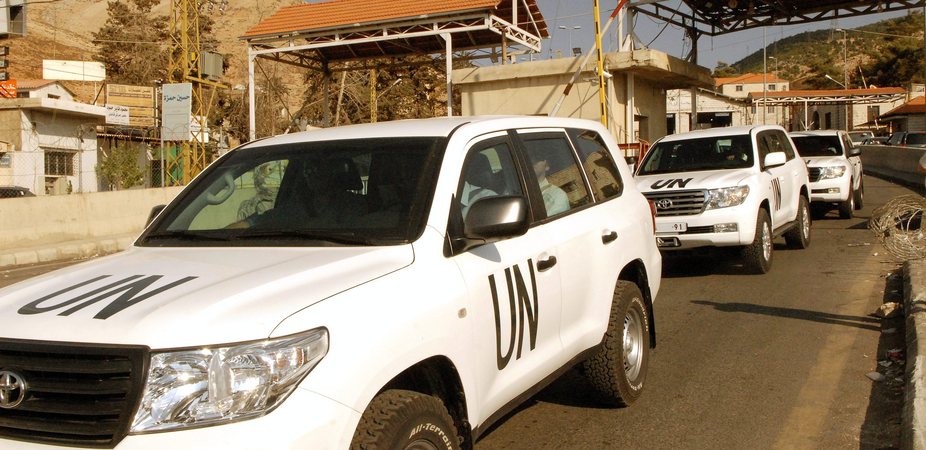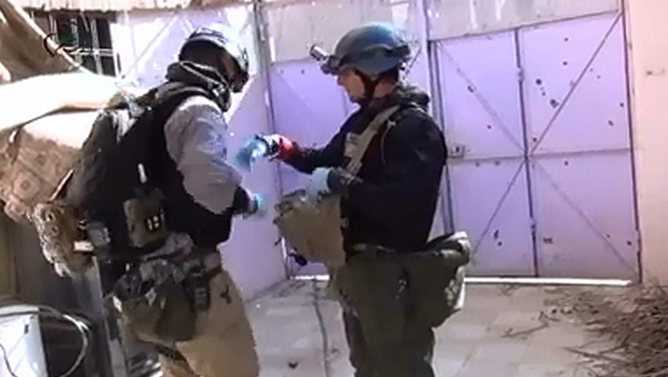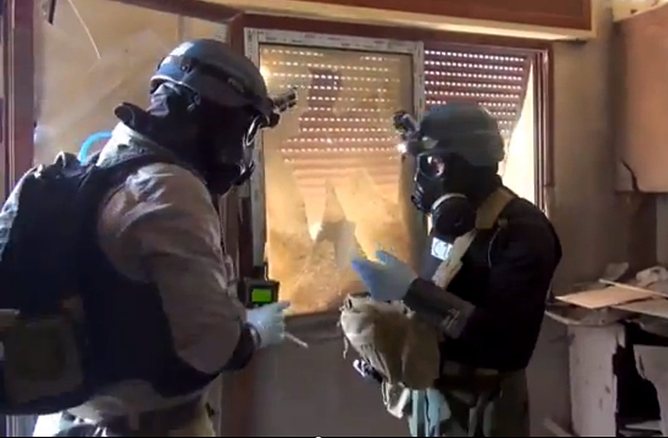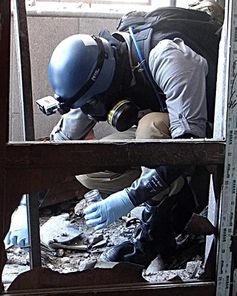Seek and Destroy: Dismantling Syria's Chemical Weapon Stockpile (Op-Ed)


This article was originally published at The Conversation. The publication contributed the article to LiveScience's Expert Voices: Op-Ed & Insights.
A team of inspectors from the United Nations and Organisation for the Prohibition of Chemical Weapons (OPCW) entered Syria on Tuesday (Oct. 1) to begin the long task of finding and disposing of the country’s chemical weapon stockpile, after a large-scale nerve gas attack in Damascus in August.
This attack was confirmed by a joint report issued by the UN, World Health Organisation (WHO) and OPCW in September, but a few days before the report was released, the Syrian government agreed to sign the Chemical Weapons Convention and a settlement was reached that the country’s stocks of chemical weapons would be destroyed within a year.
So what will the weapons inspectors be looking for – and how will they know if they’ve found everything?
Follow the paper trail
As part of the destruction process, the Syrian government provided OPCW with a list of their chemical weapon stockpiles. While the OPCW does not release information about each nation’s weapons declaration, the US government has suggested it thinks it is a truthful statement of the Syrian chemical weapons inventory.
To be sure that the Syrian government are not trying to withhold some chemical weapons, the inspection team will check that the paper trail for the declared materials makes internal sense.
This process would be a cross between quantity surveying and forensic accountancy, but with laboratory chemistry to confirm the identity and purity of the materials.
Get the world’s most fascinating discoveries delivered straight to your inbox.
For a bioweapons example of this, the UN investigation into Iraqi weapons of mass destruction found out that Iraq had imported tens of tonnes of biological growth media.
The media is used in medical diagnostics, but the amount needed for that purpose was in the hundreds of kilograms each year. This hundred-fold discrepancy allowed the inspectors to deduce that there was a hidden bioweapons program.
There are also checks in the environment outside of potential chemical weapons production and storage sites. Although many of the weapons themselves are short-lived in the natural environment, some of the precursors (chemicals that when reacted together produce a chemical warfare agent) and breakdown products survive longer and have no known natural source.
What needs to be destroyed?
Estimates suggest that the Syrian stockpile consists of :
- 300 tonnes of mustard gas (a blistering agent)
- 700 tonnes of sarin (a nerve agent)
- several tonnes of a V-series persistent nerve agent.
Comments by US officials suggest that Syria only maintained a small quantity of sarin ready to use. Most of the material was stored as precursors.
The French government suggests that these stocks are of a “binary type chemical weapon”. Toxins in binary chemical weapons are kept in the form of two physically separated precursors, making them safer to transport and store.
The Chemical Weapons Convention is clear that nations need to destroy:
- the chemical agents (bulk agents and precursors)
- the delivery systems (bombs, shells, and rockets)
- the means of producing more chemical agents.
How will they destroy the chemical weapons?
Bulk stores of chemical weapons and precursors can be processed in a similar way to any other toxic liquid. This would be accomplished by reacting them with a denaturing agent or placing them in a liquid incinerator.
Although this is a major environmental and health and safety issue, it would not be beyond most industrialised nations.
To dispose of most chemical weapons, mixing them with an alkaline solution is the favoured denaturation method. However, some agents, particularly V-series nerve agents, are better disposed of by other reactions, such as exposure to hypochlorite (ClO– ) bleach solution.
In all cases, the final mixture is usually incinerated at over 1,000°C and even then, the flue gas is scrubbed to ensure minimal toxic material reaches the environment.
Chemical agents that have been loaded into delivery systems are more difficult to dispose. Until the early 1970s it was common to dump the weapons at sea rather than try to safely disassemble them.
Since the Chemical Weapons Convention era, specially designed and often highly automated facilities have been used to dismantle the weapons, remove the chemical weapon agent, burn the explosive components, denature and incinerate the chemical weapon agents and finally decontaminate the metal casings (which then become scrap metal).
Working with precursors
Storing sarin (and possibly V-series agents) as precursors is very good news. Although the precursors and breakdown products are often toxic and/ or corrosive, they are nowhere near as dangerous as the nerve agents.
If the Syrians used the same combination of chemicals that the US developed for their binary chemical weapons program (methylphosphonic difluoride and isopropyl alcohol), the precursors are around 1,000 times less toxic than the weapons.
Another advantage for the disarmament team is that the precursor materials only work as a weapon if you have all of them. It may be that to disable the binary weapons, only one less toxic material needs to be disposed of in the short term. That would prevent the production of any more chemical weapons immediately, while a solution to disposing of the more toxic precursor is found.
If the Syrians are using the US binary weapon components, disposing of the isopropyl alcohol would be relatively easy as it is a common laboratory and household chemical but chemical weapons stocks would be harder to reestablish if the methylphosphonic difluoride component was destroyed.
It’s not all good news – there would still be several hundred tonnes of chemical weapons that would need to be destroyed. The OPCW, the US and Russia are working on a framework that would see all of Syria’s chemical weapons destroyed in the first half of 2014.
That is seen as a very tight schedule. Following Libya’s accession to the Chemical Weapons Convention in 2004 it was expected that it would take a relatively short time to destroy their roughly 25 tonnes of mustard agents.
However, the process was incomplete by the time of the fall of the Gaddafi government and is now not expected to be complete until December 2016.
To put that in perspective, the Syrians are thought to have 12 times more mustard agent and 24 times more nerve agent than Libya.
Where’s it going to happen?
It is Syria’s responsibility as the nation that owns the weapons to destroy them.
The US and Russia have previously used a combination of chemical neutralisation and incineration to eliminate their own stockpiles. Dumping the weapons at sea or burning them in the open air is explicitly forbidden by the Chemical Weapons Convention.
Although they may offer technical advice, assistance and even financial support, it is illegal for the US to import chemical weapons and Russia has also said that they will not allow the weapons to be moved onto their territory for destruction.
It is unlikely that any of Syria’s neighbours would be willing to receive the materials. That leaves trying to chemically react and incinerate up to 1,000 tonnes of lethal toxins in the middle of a warzone.
Martin Boland does not work for, consult to, own shares in or receive funding from any company or organisation that would benefit from this article, and has no relevant affiliations.
This article was originally published at The Conversation. Read the original article. The views expressed are those of the author and do not necessarily reflect the views of the publisher. This version of the article was originally published on LiveScience.





